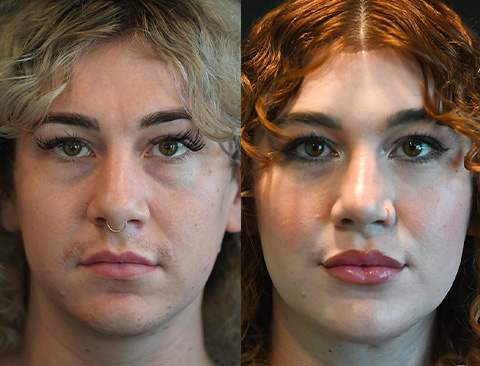Liposuction has evolved significantly over the years, but it’s essential to recognize the unique needs of LGBTQ+ patients in this field. Historically, healthcare has often overlooked these individuals, leading to a lack of tailored approaches. Addressing the specific concerns of LGBTQ+ patients can enhance their comfort and satisfaction during liposuction procedures.
Understanding gender identity and body image issues is crucial for healthcare providers. This awareness fosters trust and improves outcomes. By focusing on inclusivity, medical professionals can create a supportive environment that empowers LGBTQ+ patients. This blog post will explore effective strategies for addressing these unique needs in liposuction, ensuring every patient feels seen and respected throughout their journey.
Key Takeaways
-
Understand the unique needs of LGBTQ+ patients by considering their specific concerns and experiences during the liposuction process.
-
Promote inclusive healthcare by advocating for policies and practices that respect and support LGBTQ+ individuals in medical settings.
-
Seek specialized care for transgender patients, ensuring that surgeons are knowledgeable about gender-affirming procedures and sensitivities.
-
Choose an LGBTQ+ friendly surgeon who openly supports diverse identities and has experience working with LGBTQ+ patients.
-
Provide year-round support by connecting patients with resources, support groups, and counseling to help them through their journey.
-
Empower patients with information about their options, risks, and rights to make informed decisions about their liposuction procedures.
Understanding LGBTQ+ Needs in Liposuction
Aesthetic Goals
LGBTQ+ patients often have diverse aesthetic goals. These goals can vary widely based on cultural and societal beauty standards. Many seek to align their physical appearance with their gender identity. For example, transgender individuals may desire a more feminine or masculine silhouette. This desire often stems from the need to feel comfortable in their own skin.
Beauty standards play a significant role in shaping these goals. Media representation can influence what is considered attractive. LGBTQ+ patients may feel pressure to meet these standards. It’s essential for healthcare providers to understand these influences. They should consider how they impact a patient’s expectations and desires.
Body Dysmorphia and Gender Dysphoria
Body dysmorphia is common among LGBTQ+ individuals. This condition leads to an obsession with perceived flaws in appearance. It can affect how patients view themselves before and after surgery. Gender dysphoria also poses challenges. Patients may feel distress due to a mismatch between their gender identity and their physical body.
These issues can impact surgical outcomes. Patients might have unrealistic expectations of liposuction results. Providers must recognize these concerns early on. They should address them through thorough consultations and assessments.
Open Communication
Open communication is vital in addressing the unique needs of LGBTQ+ patients. Surgeons should create a safe space for discussions about identity and appearance. This openness helps align surgical plans with a patient’s true self. It allows patients to express their feelings about their bodies without fear of judgment.
Surgeons must ask specific questions about the patient’s identity and desired changes. Understanding their perspective can lead to better outcomes. This process builds trust and ensures that the patient feels heard.
Sharing information about realistic outcomes is crucial. Patients need to know what liposuction can achieve for them personally. Clear explanations help manage expectations and reduce anxiety.
Support Systems
Support systems are also important for LGBTQ+ patients undergoing liposuction. Family, friends, or community members can provide encouragement during recovery. Healthcare providers should encourage patients to involve supportive people in their journey.
Healthcare professionals should also be aware of local LGBTQ+ resources. Referring patients to support groups can be beneficial for emotional well-being.
Importance of Inclusive Healthcare
Respectful Environment
Creating an inclusive healthcare environment is crucial. LGBTQ+ patients often face unique challenges. Many feel uncomfortable in traditional medical settings. They may worry about discrimination or lack of understanding from staff. An inclusive environment helps to alleviate these fears. It promotes trust between patients and healthcare providers. Respecting identities fosters better communication and care.
Training staff on LGBTQ+ issues is essential. This training should cover terminology, cultural sensitivity, and specific health needs. For instance, healthcare professionals must understand the implications of gender identity on body image and self-esteem. This knowledge allows them to provide tailored support during procedures like liposuction.
Addressing Health Needs
LGBTQ+ individuals have specific health requirements that differ from others. These needs can include mental health support, hormone therapy management, and post-surgical care. For example, transgender patients may require additional counseling before undergoing liposuction. Understanding these factors ensures comprehensive care.
Healthcare providers should also be aware of the higher rates of anxiety and depression within the LGBTQ+ community. Many individuals experience stress related to societal acceptance and discrimination. Providing mental health resources can greatly improve overall patient well-being.
Preventing Discrimination
Implementing policies that prevent discrimination is vital for equitable healthcare access. Institutions must establish clear guidelines against discriminatory practices. This includes ensuring that all patients receive respectful treatment regardless of their sexual orientation or gender identity.
Equal access to services is a fundamental right. Healthcare facilities should actively promote and enforce policies that support LGBTQ+ patients. These policies can include non-discriminatory hiring practices, diverse representation in staff, and accessible complaint mechanisms for patients who experience bias.
Community Engagement
Engaging with the LGBTQ+ community helps healthcare providers understand their needs better. Hospitals can host workshops and focus groups to gather feedback directly from patients. This engagement builds a sense of community and trust.
Partnerships with local LGBTQ+ organizations can enhance outreach efforts. These collaborations can help identify gaps in services and create targeted programs for specific populations.
Specialized Care for Transgender Patients
Gender-Affirming Procedures
Liposuction serves as a vital component in gender-affirming care. Many transgender patients seek this procedure to align their physical appearance with their gender identity. Surgeons offer liposuction as part of a comprehensive transition plan. This approach includes various procedures tailored to individual needs. For example, some may want to remove fat from specific areas like the abdomen or thighs. Others might prefer contouring in different regions. Each patient’s goals should guide the surgical strategy.
Customized Surgical Approaches
Surgeons customize each surgical approach based on the patient’s gender identity and personal aspirations. Understanding these unique needs is crucial for successful outcomes. For instance, techniques may differ between those transitioning from male to female and those transitioning from female to male. Tailored methods can help achieve desired body shapes and proportions. Surgeons should discuss all options thoroughly with patients before surgery. Clear communication enhances trust and satisfaction.
Pre- and Post-Operative Support
Support before and after surgery significantly impacts recovery and satisfaction rates. Providing pre-operative counseling helps patients prepare mentally and physically for the procedure. This support can include discussing potential risks, recovery timelines, and expected results.
After surgery, follow-up appointments are essential for monitoring healing and addressing concerns. Medical teams should ensure that patients have access to resources during recovery. Emotional support is also important, as many patients face challenges during this time. Connecting them with support groups or mental health professionals can aid in their journey.
Patients often express increased satisfaction when they feel supported throughout the process. Studies show that individuals receiving comprehensive care report better overall experiences with surgical outcomes. Ensuring that LGBTQ+ patients receive specialized care fosters a more inclusive healthcare environment.
Selecting an LGBTQ+ Friendly Surgeon
Research Experience
Finding a surgeon who understands the unique needs of LGBTQ+ patients is crucial. Start by researching practitioners with experience in this area. Look for those who have worked with diverse gender identities and expressions. Familiarity with the specific health concerns of LGBTQ+ individuals can enhance the quality of care.
Surgeons should be knowledgeable about the challenges faced by transgender and non-binary patients. They need to understand how these challenges can impact surgical outcomes. A qualified surgeon will also be aware of the potential emotional and psychological aspects involved in the process.
Understanding Diversity
Seek out surgeons who demonstrate understanding and respect for gender diversity. This includes being sensitive to the terminology used within the community. A good surgeon should use inclusive language when discussing procedures. They must also create a welcoming environment for all patients, regardless of their identity.
Check if the surgeon’s office displays affirming symbols, such as pride flags or inclusive posters. These signs indicate a commitment to supporting LGBTQ+ patients. It’s important that patients feel safe and respected during their consultations and treatments.
Patient Reviews
Consider patient reviews and testimonials from the LGBTQ+ community when choosing a surgeon. Online platforms often provide insights into others’ experiences. Look for comments about the surgeon’s demeanor, professionalism, and overall care.
Positive reviews from LGBTQ+ individuals can reflect a surgeon’s ability to provide compassionate care. Pay attention to how previous patients describe their interactions. If many mention feeling understood and respected, that may signal a good choice.
Consultation Process
Schedule consultations with potential surgeons. Use this time to gauge their openness and willingness to address your concerns. Ask specific questions about their experience with LGBTQ+ patients and procedures relevant to your needs.
During the consultation, observe how comfortable you feel discussing your identity. A supportive surgeon will listen actively and respond thoughtfully. They should prioritize your comfort and ensure you feel empowered throughout the decision-making process.
Insurance Considerations
Verify if the surgeon accepts your insurance plan, especially if you have coverage for gender-affirming procedures. Some practices specialize in working with LGBTQ+ patients and may offer financial guidance.
Understanding costs upfront can help alleviate stress later on. Transparency about fees ensures informed decisions regarding surgery options.
Ensuring Year-Round Support
Continuous Care Plan
Developing a continuous care plan is essential for LGBTQ+ patients undergoing liposuction. This plan should include regular follow-up appointments. These visits allow healthcare providers to monitor healing and assess results. Mental health support is also crucial. Patients may face unique emotional challenges during recovery. Access to a therapist familiar with LGBTQ+ issues can be beneficial. This support helps in addressing feelings of anxiety or dysphoria that may arise after surgery.
Regular check-ins should be encouraged. These check-ins can happen via phone calls or video chats. They provide an opportunity for patients to discuss their progress. Any post-surgical concerns can be addressed promptly. This ongoing communication fosters trust between the patient and healthcare provider. It also ensures that patients feel supported throughout their recovery journey.
Supportive Healthcare Network
Establishing a network of supportive healthcare providers is vital for comprehensive care. This network should include surgeons, primary care doctors, and mental health professionals. Each member plays a role in the patient’s recovery process. For example, a primary care doctor can help manage overall health while a surgeon focuses on surgical outcomes.
Patients should feel comfortable discussing their needs with all members of this network. Open conversations about unique experiences help tailor care plans effectively. Having access to LGBTQ+-friendly resources enhances the quality of care. This network provides ongoing advice and support, making the recovery process smoother.
Addressing Post-Surgical Concerns
Addressing post-surgical concerns is critical for ensuring patient satisfaction. Common issues include pain management and changes in body image. Providing clear information about what to expect after surgery can alleviate fears. Surgeons should explain potential side effects and normal healing processes.
Creating an environment where patients feel safe to voice concerns is important. Encourage patients to share any discomfort they may experience after surgery. This feedback allows healthcare providers to adjust care plans as needed. Regular discussions about body positivity can also help improve self-esteem.

Importance of Community Resources
Utilizing community resources can enhance support for LGBTQ+ patients. Local organizations often offer workshops and support groups focused on body image and mental health. These resources create a sense of belonging and connection among individuals with shared experiences.
Encouraging participation in these community programs can foster resilience in patients. Feeling part of a supportive community reduces feelings of isolation during recovery. Patients should be informed about available resources before and after surgery.
Empowering Patients with Information
Comprehensive Resources
LGBTQ+ patients seeking liposuction need access to comprehensive resources. Many organizations provide tailored information about procedures. The American Society of Plastic Surgeons offers guidelines specific to LGBTQ+ individuals. They outline what to expect during the process. This includes pre-operative assessments and post-operative care.
Local LGBTQ+ health centers also serve as valuable resources. They often host workshops on cosmetic procedures. These events can help patients understand their options better. Online forums allow patients to share experiences and advice. These platforms foster community support and knowledge sharing.
Risks and Benefits
Understanding the potential risks and benefits of liposuction is crucial. Common risks include infection, scarring, and anesthesia complications. Patients should discuss these risks with their healthcare providers. It’s important to weigh these against the benefits of improved body image and confidence.
Realistic outcomes are another key factor. Liposuction can enhance body contours, but it is not a weight-loss solution. Patients should have a clear understanding of what to expect after surgery. Consulting with experienced surgeons helps set realistic goals.
Informed Decision-Making
Encouraging informed decision-making empowers patients. Discussions about all available options are essential. Some may consider alternatives like diet and exercise before surgery. Others might explore non-invasive treatments such as CoolSculpting or Kybella.
Surgeons should provide detailed explanations of each option’s pros and cons. This transparency builds trust and allows patients to make choices aligned with their values and needs.
Support Networks
Support networks play a vital role in patient empowerment. Connecting with other LGBTQ+ individuals who have undergone liposuction can be beneficial. They can share their journeys, including what worked well and what challenges they faced.
Mental health professionals can assist in navigating emotional aspects of surgery. Body dysmorphia or anxiety related to surgery may arise for some patients. Professional support helps address these feelings effectively.
Continuous Education
Continuous education is necessary for both patients and healthcare providers. Training programs focusing on LGBTQ+ health issues can improve provider sensitivity. This ensures that all patients receive respectful and competent care.
Healthcare providers should stay updated on best practices regarding LGBTQ+ patient care. This includes understanding unique medical needs and concerns related to liposuction.
Building a Supportive Environment
Welcoming Atmosphere
A welcoming clinic atmosphere is crucial for LGBTQ+ patients. This environment must promote safety and respect. Patients often feel anxious about seeking treatment. A friendly space can ease these concerns. Staff should greet everyone with kindness and understanding. This simple act builds trust and comfort.
Visual cues can also help create an inviting space. Posters, brochures, and other materials should reflect diversity. These elements signal that the clinic values all identities. Such representation fosters a sense of belonging for LGBTQ+ individuals.
Inclusive Training
Training staff in inclusive language is essential. Staff members should learn to use terms that affirm each patient’s identity. This practice shows respect and understanding. Cultural competence training helps staff recognize unique challenges faced by LGBTQ+ patients.
For example, using correct pronouns can make a significant difference. It shows that the clinic respects individual identities. Regular workshops can keep staff updated on best practices. Ongoing education helps maintain a supportive environment.
Feedback System
A feedback system is vital for improving patient experiences. Clinics should encourage patients to share their thoughts after visits. An anonymous survey can provide valuable insights into patient satisfaction.
Listening to feedback allows clinics to address concerns directly. For instance, if patients express discomfort with certain procedures, clinics can adjust their approach. Continuous improvement demonstrates commitment to patient care.
Establishing a regular review process ensures that feedback leads to action. This process can include monthly meetings to discuss patient input. Staff can brainstorm solutions together, fostering teamwork and dedication.
Emotional Support
LGBTQ+ patients may face emotional challenges during their treatment journey. Providing access to counseling services can be beneficial. Trained professionals can offer support tailored to individual needs.
Support groups are another option for emotional connection. Creating spaces where patients can share experiences fosters community and understanding.
By addressing both physical and emotional needs, clinics show they care about the whole patient experience.
Accessing Resources and References
LGBTQ+ Providers
Finding healthcare providers who are sensitive to the needs of LGBTQ+ patients is crucial. Many organizations maintain directories of LGBTQ+ friendly healthcare professionals. The Human Rights Campaign offers a list of inclusive healthcare facilities. The Gay and Lesbian Medical Association provides resources to locate affirming doctors. These lists help patients find providers who understand their unique experiences.
Support groups also play an important role. Organizations like PFLAG and The Trevor Project offer community support. They connect individuals with local chapters where they can share experiences and learn from others. These connections can ease the stress of seeking medical care.
Educational Materials
Educational materials are vital for understanding health issues specific to LGBTQ+ individuals. Research studies focus on how gender identity and sexual orientation impact health outcomes. For example, studies published in journals like “Transgender Health” highlight disparities in care for transgender patients.
Many online resources provide information about liposuction and other aesthetic procedures. Websites such as GLMA’s Health Professionals Guide offer insights tailored to LGBTQ+ needs. Patients can access articles that discuss both physical and mental health aspects related to body image and aesthetics.
Advocacy Organizations
Advocacy organizations serve as essential guides for navigating healthcare systems. Groups like Lambda Legal advocate for equal rights in healthcare settings. They offer legal assistance to those facing discrimination based on sexual orientation or gender identity.
The National Center for Transgender Equality also provides resources for navigating medical care. Their website contains information on patient rights and what to expect during medical visits. This guidance helps patients feel more empowered when seeking treatment.
Connecting with these organizations can make a significant difference. They provide not only information but also emotional support during challenging times.
Support Networks
Support networks extend beyond advocacy organizations. Online forums and social media groups allow patients to share experiences and seek advice from peers. Platforms like Reddit have dedicated communities focused on LGBTQ+ health topics, including cosmetic surgery.
Local community centers often host workshops or informational sessions about health topics relevant to LGBTQ+ individuals. These events provide opportunities for education and connection with others facing similar challenges.
By leveraging these resources, LGBTQ+ patients can find supportive environments for their healthcare needs. Accessing knowledgeable providers, educational materials, and advocacy organizations creates a comprehensive support system.
Final Remarks
Addressing the unique needs of LGBTQ+ patients in liposuction is crucial for fostering a supportive healthcare environment. You deserve care that respects your identity and offers specialized support. By selecting an LGBTQ+ friendly surgeon, accessing resources, and ensuring year-round assistance, you can navigate your journey with confidence.
Empower yourself with information and build connections within a community that understands your experiences. The path to feeling comfortable in your skin starts with informed choices and supportive care. Take action today—research, reach out, and advocate for the care you deserve. Your health and happiness matter.
Frequently Asked Questions
What are the unique needs of LGBTQ+ patients in liposuction?
LGBTQ+ patients often seek procedures that align with their gender identity. They may require specialized care and understanding from healthcare providers to address specific concerns related to body image and gender affirmation.
Why is inclusive healthcare important for LGBTQ+ patients?
Inclusive healthcare fosters trust and comfort, allowing LGBTQ+ patients to openly discuss their needs. This approach leads to better health outcomes and enhances patient satisfaction by ensuring that all individuals feel respected and valued.
How can transgender patients prepare for liposuction?
Transgender patients should consult with experienced surgeons who understand their unique needs. Preparing involves discussing medical history, goals, and any hormonal treatments, ensuring a tailored approach to their care.
What should I look for in an LGBTQ+ friendly surgeon?
Seek a surgeon with experience in LGBTQ+ care, positive reviews from previous patients, and a commitment to inclusivity. They should create a welcoming environment and be open to discussing your specific concerns.
How can I ensure ongoing support after my liposuction procedure?
Post-operative support can include follow-up appointments, access to counseling services, and connections with local LGBTQ+ support groups. Open communication with your surgeon is crucial for addressing any concerns during recovery.
What resources are available for LGBTQ+ patients considering liposuction?
Many organizations provide resources such as support groups, informational websites, and directories of LGBTQ+-friendly healthcare providers. Researching these resources can help you make informed decisions about your care.
How can I build a supportive environment during my recovery?
Surround yourself with supportive friends and family who respect your journey. Joining online or local LGBTQ+ communities can also provide emotional support and valuable insights during your recovery process.





